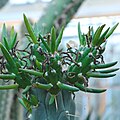Austrocylindropuntia subulata
| Austrocylindropuntia subulata | |
|---|---|

| |
| Young plant | |
| Scientific classification | |
| Kingdom: | Plantae |
| Clade: | Tracheophytes |
| Clade: | Angiosperms |
| Clade: | Eudicots |
| Order: | Caryophyllales |
| Family: | Cactaceae |
| Genus: | Austrocylindropuntia |
| Species: | A. subulata
|
| Binomial name | |
| Austrocylindropuntia subulata (
Backeb. | |
| Synonyms[2] | |
| |
Austrocylindropuntia subulata is a
Description
Austrocylindropuntia subulata can reach heights up to 4 metres (13 ft), with numerous branches. The elongated, slightly brittle branches are up to 50 centimetres (20 in) long. The stems are marked by rhomboid to ovate bumps in a few spiral rows. At the tip of each bump is the areole, from which grow one to four straight, grayish-white spines up to 8 centimetres (3 in) long. The awl-like rudimentary leaves are up to 12 centimetres (5 in) long.
The orangy-pink flowers are up to 6 centimetres (2+1⁄4 in) long. The long, warty hypanthium is covered by rudimentary leaves up to 2 centimetres (3⁄4 in) long. The fruit are ovoid or club-like and sometimes thorny. They are up to 10 centimetres (4 in) long.
Distribution
A. subulata probably comes from the Peruvian Andes, where it is common at altitudes above 3,000 metres (9,800 feet). Today it has been naturalised in
Classification
The first description as Pereskia subulata took place in 1845 by Friedrich Mühlenpfordt.[5] Curt Backeberg classified it in the genus Austrocylindropuntia in 1942.[6]
References
- . Retrieved 19 November 2021.
- ^ "The Plant List: A Working List of All Plant Species".
- ISBN 978-3-642-05597-3, S. 233.
- CABI
- ^ F. Mühlenpfordt: Einige neue Cacteen. In: Allgemeine Gartenzeitung. Band 13, Nummer 44, 1845, S. 347 (online).
- ^ Cactaceae. Jahrbücher der Deutschen Kakteen-Gesellschaft 1941. 1942, S. 12.











